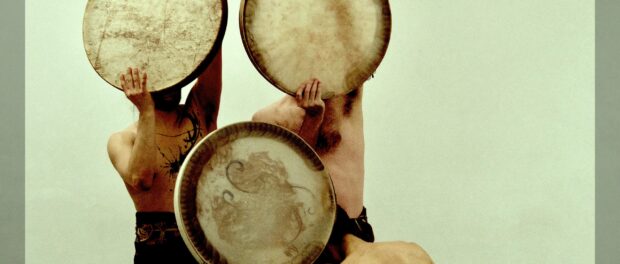Sashar Zarif’s Kismet
Kismet is a ritual of transforming fate to Destiny. It asks, what will you do with what is given to you? A thrumming auditory call reverberates among the quartet of dancers and singers whose breaths and bodies collaboratively create painterly images, spilling one into another. A river of dance and sound whose ebb and flow are as hypnotising and collective as any body of water. A self-study through memory which investigates the idea that identity is not the product but rather the process of an ongoing constructive negotiation amongst the cultures, languages, and experiences that we each carry with ourselves.
Kismet is presented in the contemporary style of Mugham which is an integrated practice Zarif has developed that blends dance, music, and storytelling inspired and informed by the Sufi and Shamanic rituals of Islamic societies. In it, words communicate the mental, music transmits the emotional, and dance conveys the physical. These influences on the work are deeply rooted in Sashar Zarif’s nomadic ancestry.
Montreal Rampage’s Sinj spoke to the artist Sashar, to discuss this amazing piece:
Sinj: Can you please share with us your thoughts on how you see identity as a navigation of cultures, languages, experiences, histories?
Sashar: I am simultaneously committed to developing my own practice, which is grounded in a deep, mystical connection to dance, while sharing cultural perspectives.
My earliest, most enduring artistic influence remains my immigrant grandmother. The dance that began on her carpet, the songs accompanied by her hand drum, and the stories animated with her bamboo fan carried me across many countries, cultures, and through years of identity negotiation.
This ongoing self-study through memory further investigates the idea that identity is not the product but rather the process of an ongoing constructive negotiation between the cultures, languages, and experiences that I carry within me, that we each carry within ourselves.
As a Canadian artist, I have had the privilege of building my artistic practice in a culturally diverse environment. Inspired by the roots of the words contemporary (“con” meaning “with”, and “tempo” meaning “time”) my creative mandate is to respect the traditions that carry our past, while exploring the present and opening paths of new possibilities for the future. My guide is a tree that stands healthy on its roots while rejuvenating in the air and prepares for fruition.
Sinj: What inspired you to frame identity and its evolution through music? Is there a personal story that you are telling?
Sashar: Part of my journey was about following my grandmother’s approach in my struggles of displacement and finding a place of belonging. My grandmother, in her nineties, was my first mentor in life who introduced me to life through dance, music and stories. A migrant woman, she carried her home with her: a carpet from her father’s home. That carpet was her earth, holding her body and breath that kept singing the memories of connections and dancing the echoes of disconnections. I was raised on the same carpet through the same stories of physical, emotional, and mental longings. After her death on the completion of the first decade of my life, I continued her legacy in my own journey with connections and disconnections for another two decades. The other part of my journey has been about leaving the carpet, discovering my own relationship with the hand drum, and adding my own decorations to the edges the bamboo fan. My journey is an ongoing negotiation of my identity that goes beyond telling my inherited stories in order to create a fluid relationship with time and place.
Sinj: How have the Sufi and Shamanic rituals informed this piece?
Sashar: All my work is inspired by the Sufi and Shamanic ritualistic practices. I encourage my dancer to experience not perform, experience the work as the out lookers witness this, (no audience but witnesses). My roots are in Central Asia, so I have spent a lot of time in the past twenty-five years of my artistic practise, living in different places, including rural communities, and learning different customs and traditions. The Sufi and Shamanic traditions have thus informed my work deeply.
Sinj: The Sufi tradition symbolized a departure from the normative strain of Islam, is your work a counterpoint to religion and how religion frames identity?
Sashar: We have to understand that the word “Sufi” is as misused and lost in translation, romanticization, and politics as words such as spirituality, diversity, tolerance, identity, Middle East, freedom, dream, hope, and arts.
Most of the Sufi sects that I know of have emerged as an echo/reaction to their contemporary situations, in particular the organized ruling religious governments or social-political structures. These sects seem to be inspired by a progressive approach to life, spirituality, and individuality. Sufism is referred to as Tariqat or the “how to”. Tariqat.
There are many Sufi sects and practices that have members from different religions or beliefs. So, I think it depends on what tradition we are focusing on. I am focusing on the transitions that favour the process of inquiry or in another word relate to the journey as the destination.
Sinj: How do you see your piece being situated in a world that is so full of noise?
Sashar: It is very important to remember that in all the strife and noise that we find ourselves, we have to continue to try and share hope and inspire people to continue to look for peace and love. I want to share a couplet from a poem by Pakistani poet Allama Mohammad Eghbal:
“Although I have lived long,” said the humble shore,
“Oh, I have never been certain of what I am.”
The wave, leaving him, swiftly bounded and said:
“I exist when I move, when I do not I don’t exist.”
Kismet will be at the MAI (Montréal, arts interculturels), 3680 Jeanne-Mance, Montreal – March 30th to April 2nd at 7:30 p.m. $28, or $36 package deal with Off Centre. Full ticket info at: www.m-a-i.qc.ca/en/boxoffice






